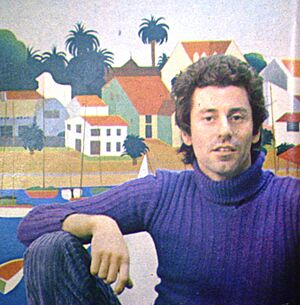Nicolás García Uriburu facts for kids
Nicolás García Uriburu (born December 24, 1937 – died June 19, 2016) was an artist from Argentina. He was also a landscape architect and an ecologist. An ecologist is someone who studies how living things interact with their environment. His art often focused on environmental problems, like water pollution. He used a special type of art called land art to make people think about these issues.
Contents
Life and His Art Journey
Nicolás García Uriburu was born in Buenos Aires, Argentina, in 1937. He started painting when he was young. In 1954, he had his first art show. He studied architecture at the University of Buenos Aires. In 1965, he moved to Paris, France, with his wife, Blanca Isabel Álvarez de Toledo. They had a child named Azul.
Early Art Styles
In 1968, his sculpture called Three Graces won a big award. This artwork was in the pop art style. Pop art uses images from popular culture, like advertisements. Later, he explored conceptual art. This type of art focuses on the idea behind the artwork, not just the finished product. He made an artificial garden using clear plastic at the Iris Clert Gallery. This project showed his new interest in protecting the environment.
Making Rivers Green
In June 1968, Nicolás was invited to the famous Venice Biennale art show. There, he did something amazing. He dyed the Grand Canal in Venice a bright green color. He used a special, harmless dye called fluorescein. This dye glows green when tiny living things in the water react with it.
Between 1968 and 1970, he repeated this art project. He dyed parts of the East River in New York and the Seine River in Paris. He also tried to dye the polluted Riachuelo River in Buenos Aires. Instead, he dyed a part of the much larger Rio de la Plata.
Art for Environmental Awareness
Nicolás García Uriburu was a pioneer in land art. Land art uses the natural landscape to create art. In 1970, he made colorful pictures over photos of his green rivers. He allowed anyone to copy these photos. His goal was to spread awareness about the growing problem of water pollution around the world.
Besides protecting the environment, his art also showed ideas about humanism. Humanism focuses on human values and concerns. He explored the conflict between society and nature. Some of his works included Unión de Latinoamérica por los ríos (Latin America Union for Rivers) and No a las fronteras políticas (No to Political Borders).
More Green Water Projects
He continued to use fluorescein in other waterways. He dyed the Lac de Vincennes in Paris (1971) and the Trocadéro fountains (1972). He also dyed parts of the Port of Nice (1974) and the Port of Antwerp (1974).
His art also showed endangered species and habitat loss. Habitat loss is when animals lose their natural homes. In 1975, he won a big award at the Tokyo Biennale.
Working with Joseph Beuys
In 1981, the German Green Party invited him to dye the Rhine River. This was part of a protest called "Wasserfest" (Water Festival). There, he met Joseph Beuys. Beuys was a famous artist and a founder of the Green Party. Beuys asked if they could work together. The next year, they collaborated at the Kassel Documenta 7 art show. They helped plant 7,000 oak trees as part of Beuys's project. Both artists believed in similar ideas about humanism, society, ecology, and freedom.
Return to Argentina and Later Work
Nicolás García Uriburu returned to Buenos Aires in 1982. He then planted 50,000 trees. He kept working on tree-planting efforts in the city. He also started painting portraits. In 1993, he had a show called Utopía del Sur (Southern Utopia) at the Ruth Benzacar Gallery. This show was dedicated to his environmental cause.
In his later years, he led tree-planting projects in Uruguay. He also organized protests with Greenpeace about the pollution of the Riachuelo waterway in Buenos Aires. He taught art to high school students. He also led a foundation named after him. This foundation shows his art and has a museum of Pre-Columbian art.
In 2017, Nicolás García Uriburu's work was shown again at the Venice Biennale. This time, it was part of the main exhibition called VIVA ARTE VIVA.
Prizes and Recognition
Nicolás García Uriburu received many awards for his art and environmental work:
- Gran Premio de Pintura Nacional (National Grand Prize in Painting, Argentina 1968)
- Prix Lefranc (Paris, 1968)
- 1st place Tokyo Biennial (Tokyo, 1975)
- Premio Braque (Buenos Aires, 1993)
- Primer Premio Otium Ecología (Buenos Aires, 1993)
- Fondo Nacional de las Artes’ Premio a la Trayectoria (National Fund for the Arts: Career achievement award, Argentina 2000)
- Platinum Konex Award (Konex Foundation, Argentina 2002)
- Premio Carreras Creativas (Creative Careers Award, Universidad del CEMA, Buenos Aires, 2010)
See also
 In Spanish: Nicolás García Uriburu para niños
In Spanish: Nicolás García Uriburu para niños
- Land art
- Joseph Beuys
- Conservation movement


